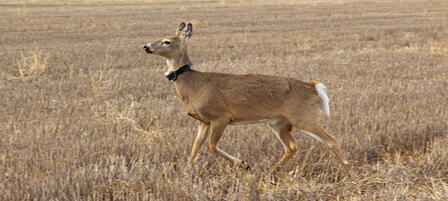First Stage Of Deer Research Project Complete

EMPORIA – A comprehensive deer research project being conducted by Kansas State University and the Kansas Department of Wildlife, Parks and Tourism (KDWPT) is off to a good start. The collaborative effort, which is designed to learn more about mule deer and white-tailed deer in northwestern Kansas, began this February with the goal of capturing 120 deer and fitting them with GPS radio transmitters. That portion of the project is complete.
Quicksilver Air, Inc. was hired to capture deer using a helicopter and nets. After a quick health check, including taking blood samples, captured bucks were fitted with GPS collars and released. Does were transported back to a mobile processing center where ultrasound was used to determine pregnancy rates, blood samples were taken, ear tags were attached and GPS collars fitted. Before pregnant does were released, they received small vaginal insert transmitters that will drop out when they give birth, allowing researchers to locate and capture fawns. The goal is to fit 80-90 fawns with radio collars this spring.
The entire capture/collar process was completed in four days. Once the helicopter crew delivered does to the processing location, Kansas Cooperative Fish and Wildlife Research Unit staff, K-State graduate students, two veterinarians, KDWPT staff and Kansas Bowhunters Association volunteers worked together to efficiently process the deer before release. Area landowners, who allowed access to their land for this study, also assisted.
Now the monitoring begins. Researchers want to learn more about reproductive rates, deer movement, survival of different year classes, causes of mortality, and species interactions. Results will also provide insight on deer densities, deer-human interactions, crop damage, and the effects of landscape changes on deer populations. The three-year study is the first of its kind in Kansas, and biologists are anxious to see results.
Contact information is attached to each radio transmitter and hunters who harvest a marked deer should contact researchers to provide information on where and when deer were harvested. Cooperating landowners will be provided with data gathered, so they can better manage deer on their land, and a written report will be published and available to the public online at the conclusion of the project.
-30-









